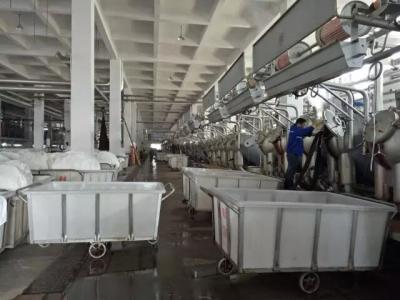As one of the important raw materials for textile printing and dyeing, textile printing and dyeing auxiliaries are used to improve the quality of textile printing and dyeing products, thereby increasing the added value of textiles. The textile printing and dyeing auxiliary industry is an application technology of the textile printing and dyeing industry in the fine chemical industry and belongs to the edge of the chemical and printing and dyeing sciences. Therefore, it has the following characteristics:
Printing and dyeing auxiliaries have low fixed investment, high added value and large profits
Auxiliaries are a small branch of the fine chemical industry and have all the characteristics of the fine chemical industry. Its fixed asset investment is closely related to its product characteristics.
As we all know, there are many varieties of textile printing and dyeing auxiliaries, and their tonnage is small. Their production methods are different from those of other organic and inorganic chemicals. They have short processes, fewer unit reactions, and most of them use compounding and emulsification technologies. Their synthesis is limited to key raw materials, which is the core technology. Their output is even smaller, and their equipment has strong versatility. Therefore, the main fixed asset investment is much less than other chemical industries.
In addition, printing and dyeing auxiliaries have fewer equipments, short construction periods, most raw materials are purchased from the market, and compounding technology is used. The production cycle is short, so they have the characteristics of less input, fast output, and quick results.
Printing and dyeing auxiliaries are products designed for special user groups and are the most downstream in the chemical product chain. Although the production process is simple, the added value is extremely high and the technical content is high. From an international perspective, the statistical results of sales and profit margins of the top 100 chemical companies in the world also show that the top 10 companies with high profits are all in the fine chemical industry, reflecting the characteristics of the fine chemical industry with little investment, short investment cycle and high benefits.
Printing and dyeing auxiliaries have multiple varieties and small batch sizes
Printing and dyeing auxiliary products have strong specialization, and their users are in another industry. Different printing and dyeing auxiliaries are designed for different fabrics, different processes, different production processes, and different fabric styles. Currently there are nearly 100 categories of printing and dyeing auxiliaries in the world with 15,000 varieties, and in China there are more than 1,000 varieties with a production volume of more than 3 million tons per year, which surpasses all other industries.
This feature is consistent with the characteristics of fine chemicals, because the product production cycle is short, the investment is small, the profit is high, the competition is fierce, and the product renewal is fast. In addition, the diversified demand of the textile industry is also one of the reasons for this phenomenon.
Most printing and dyeing auxiliaries are produced intermittently, and the equipment has strong versatility
One of the characteristics of chemical production is strong versatility. Unlike the machinery industry, the unit of reactions is not limited to a certain number of unit operations, and the equipment is standardized. Especially for printing and dyeing auxiliaries, most of them use compounding technology. The common equipment is just an enameled reaction kettle, storage tank, high-level tank, etc. It is extremely easy to design a set of equipment for multiple purposes in the process design, to reduce fixed asset investment, avoid large-scale continuous production, and adopt intermittent production. It is close to the market and produced on demand, avoiding unnecessary losses.
Printing and dyeing auxiliaries use a lot of compounding technology
In order to meet various specialized needs, many products obtained by chemical synthesis must not only be processed into various dosage forms, but also often need to add multiple other reagents to compound them.
Due to the special nature of the application object, it is difficult to use a single compound to meet the requirements. Therefore, the formulation research becomes a decisive factor. The products developed by using compounding technology have the functions of enhancing, modifying, and expanding the application range, and their performance often exceeds that of products with a single structure. Therefore, mastering compounding technology is an extremely important aspect for making textile printing and dyeing auxiliaries products competitive in the market.
Printing and dyeing auxiliaries have high requirements for technical services and technical support
Textile printing and dyeing auxiliaries belong to a development and management-oriented industry. While vigorously developing new products and technologies, it is also necessary to spend more energy on researching product application technology and providing comprehensive technical services and technical support.
The developed industrial countries in the world attach great importance to this. Their technical development, business management, and product sales (including technical services) personnel ratio is roughly 2:1:3. They also select people with good business quality and the most practical experience to be responsible for sales and technical services, feedback the information obtained during the sales process to the planning and production department in time, revise the plan, adjust the production to ensure the product's good sales, and improve the enterprise's competitive ability.



 English
English  日本語
日本語  Español
Español  tiếng việt
tiếng việt  Türkçe
Türkçe  ไทย
ไทย  українська
українська  हिंदी
हिंदी  বাঙালি
বাঙালি  اردو
اردو 

